

Readers of TRON Web are well acquainted with character codes and character sets. (Those who aren't should read this introduction and this follow-up piece.) They know that the character code system for the BTRON-specification operating system, TRON Code, handles character codes as two-byte values on a series of two-byte planes that are endlessly extensible. They know that U.S. computer industry is developing the Unicode character code system that consists of two planes: a Basic Multilingual Plane that has two-byte codes for the most frequently used characters, and a "surrogate pairs plane" that has room for an additional 1 million characters based on a four-byte coding scheme. The TRON Project policy is not to select permissible characters or draw up character sets, but rather include all characters and character sets. The Unicode Consortium's policy is to unify the most commonly used Chinese characters in China, Japan, and Korea, so called "Han unification," which means it is very much into selecting permissible characters and creating character sets.
In addition, TRON Web readers are also aware that three projects to create unabridged kanji (Chinese character) character sets were launched in Japan--the eKanji, Konjaku Mojikyo, and GT Font projects. They know that the GT Font, which includes every known kanji ever used for Japanese, is included in the BTRON3-specification Cho Kanji operating system, and that this operating system comes equipped with 176,175 characters, the largest character set available today for a personal computer. They also know that due to interference from the U.S. government, the BTRON-specification operating system with its robust character processing system never became a widely used standard. However, one thing they probably don't know is that Unicode did not become a de facto standard. There is widespread resistance to Unicode even outside the TRON Project for a variety of reasons, and that begs the question: what are Japanese computer users doing today to process infrequently used kanji if they are not using Personal Media Corp.'s Cho Kanji?
The answer is that users are filling in the user defined character areas of their current operating systems with kanji acquired from various sources. Hitachi, Ltd., for example, has an on-line electronic character dictionary called Gomanetsu, literally '50,000 joys', which provides a high quality font that consists of 71,303 characters. Gomanetsu, which can only be used for a fee inside Japan, is mainly used by public organizations, such ward offices, city halls, and prefectural and national government organs. In addition, Fujitsu Ltd. offers the JEF Extended Variant Conversion Table, and NEC Corporation offers the JIPS Extended Character Set. Needless to say, there are other extended character set offerings from other computer makers, and then there are the user defined characters and fonts that publishing houses have created for in-house use. The big problem comes when these user defined characters, which are called gaiji in Japanese, have to be transferred from one system to another. There is a total lack of compatibility among the gaiji currently in use.
It was to address this problem of the lack of compatibility of user defined characters among various computer systems that Prof. Ken Sakamura announced, and then demonstrated, the TRON Font Traceability System (TFTS) at the "TRON Multi-Character Application Seminar," which was held by the TRON Association at the Meilparque Hotel in the Shibakooen district of Tokyo on March 10. One of the advantages that TRON Code has over other character code systems, such as Unicode, is that it is a "meta code," which means that it can include all known character sets plus even standard user defined character sets in desktop publishing software. Thus it is possible to use TRON Code as a "pivot character code" and create a gaiji conversion program and a gaiji conversion server to allow the gaiji of one maker's system to be easily converted into those of another. Specifically, Prof. Sakamura's solution to the problems created as a result of the use of gaiji, which are used in tables of roughly 1,800 characters per application, is as follows:
|
1. Using TRON Code, assign a unique code to "gaiji."
2. Using ucode, assign a unique code to all "gaiji tables" (utilizing the mechanisms of the uID Center).
|
After explaining TFTS, which is mainly aimed at the printing and publishing industries for use on their current operating systems and software applications, Prof. Sakamura demonstrated the TFTS system with the help of Mr. Akira Matsui of Personal Media. Taking the character ryuu 'dragon' from the name of Rashomon author Ryunosuke Akutagawa, which requires a variant kanji to write correctly, and using drag and drop methods, the character ryuu was automatically converted and then sent via a network to a computer using MS Windows. The InDesign desktop publishing application was then opened, and the proper character appeared in the corresponding document. As for gaiji tables, uID tags attached to an Akutagawa novel, the famous Kojien dictionary, and a telephone directory called Hello Pages were activated using a Ubiquitous Communicator, which then displayed which gaiji being used in the publications. Prof. Sakamura summed up by saying this new system opened up the road to using TRON Code on MS Windows and Macintosh.
The YRP Ubiquitous Networking Laboratory held a press conference in its Gotanda headquarters on March 24 to announce the commencement of the "Autonomous Movement Support Project," which is aimed at the development of technologies to allow people to move around on their own without the help of others. The technologies, which are being developed with the cooperation of the Japanese government, are based on "context awareness" and the provision of "environmental information." This is done through the use of ubiquitous ID tags--both RFID tags and new generation barcodes loaded with 128-bit identifier ucodes--and the Ubiquitous Communicator, a PDA-size device for communicating with people, things and the environment. Although the technology development is receiving input from Mr. Sadao Hasegawa, a visually disabled Braille specialist from the Japan Braille Library, the technologies being developed can also be used to support others, such as foreign tourists, move from place to place without the help of others.
As with all TRON-based technological developments, the AMS project takes existing technologies into account and integrates them into a highly functional macro architecture (see the diagram below) based on universal design principles. Universal design allows the technology to be useful to all the people within a society. The component technologies that enable correct positioning are mainly non-TRON technologies. Wide area positioning is done using GPS and electronic reference point networks, local area positioning is done using wireless LAN technology, zone positioning within the local area is done using infrared and Bluetooth, and point positioning is done using ucode-compatible RFIDs and optical codes, such as barcodes. All of these positioning systems will be accessed by the Ubiquitous Communicator, an experimental device that when commercialized will allow its users to communicate with people, places, and things. This scheme has been a goal of the TRON Project since its inception, when the Communication Machine was proposed.
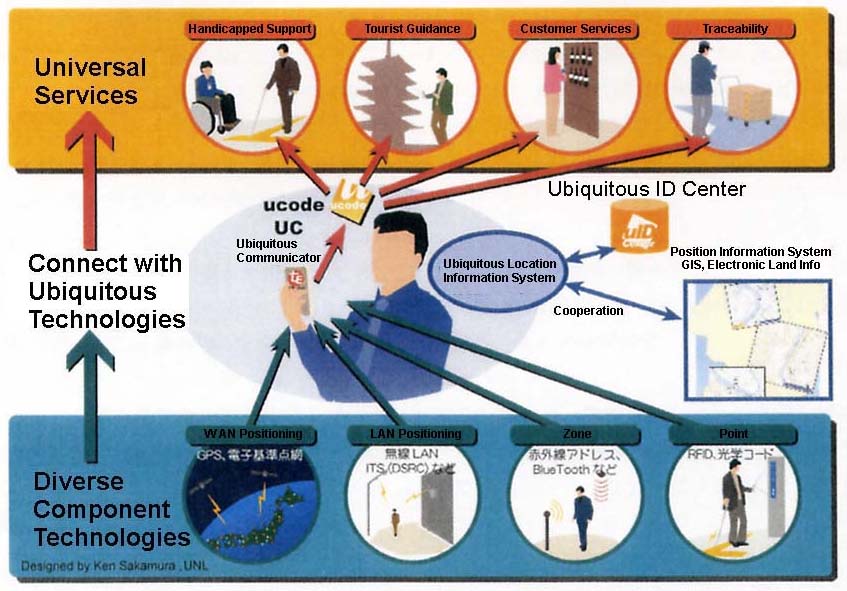
As can be seen in the diagram above, a wide variety of services can be offered when things are equipped with a unique item number and places are assigned a unique location number. The handicapped obtain the ability to move around society without the aid of others. Tourists from foreign countries who do not speak or read the local language can also find their way around, and customers at stores and restaurants can be given higher level services without the hiring of additional personnel. There are, of course, the obvious inventory tracking benefits, but those are something that have been known for a long time. Perhaps most important of all is that the contents for all these services can be created using existing Web page creation technologies, so content creators do not have to learn new skills to provide advanced service content features for the AMS system. The Ubiquitous Communicator is a multimedia device, and it can display or play back whatever information is available for a particular item or location.
During the press conference, Prof. Sakamura held up a small box called a "ucode beacon," which allows for environmental communication with the Ubiquitous Communicator at greater ranges than RFID chips. Previously, this device has been proposed for zone uses such menu readout in restaurants, but in the post press conference demonstration (see below), it was used in conjunction with pedestrian guidance blocks for the visually handicapped to alert them when they are walking off track. Thus, one of the complaints about the electronic tag equipped Braille system unveiled at TRON SHOW 2004 has been addressed. In addition to the incorporation of the ucode beacon to aid autonomous movement, new technologies were demonstrated. These included intelligent barrier devices that give off warnings when approaching construction sites, building information systems, an intelligent vending machine, an intelligent train station ticket wicket, intelligent shopping displays, and even intelligent box lunches of the type sold at train stations in Japan.
| In the picture on the right, a YRP UNL researcher is demonstrating how the visually disabled can navigate using electronic tag equipped Braille pedestrian blocks. The white cane serves as an antenna, while data are read out using a voice synthesis function incorporated in the Ubiquitous Communicator in the researcher's left hand. Very detailed data are given out via the voice synthesis function, including distance data plus what is in both directions at the junction just in front of the researcher. If the researcher moves either to the left or the right of the Braille pedestrian blocks, ucode beacons in the ceiling sense the disabled person moving off course and issue a warning. This is an improvement as a result of feedback. |
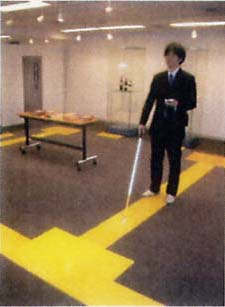 |
| Japan is famous for having a model industry that creates models of foods that restaurants sell. These are normally displayed outside the establishment, but they are of little use to either the visually disabled or foreigners who cannot read Japanese. In the picture on the right, the YRP UNL researcher demonstrates how the Ubiquitous Communicator can be used to obtain information about restaurant menu items. |
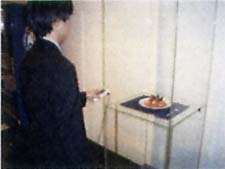 |
| Japan is even more famous for its vending machines, which are truly ubiquitous throughout the country and probably sell a wider variety of items than vending machines in any other country in the world. In the picture on the right, the YRP UNL researcher, who is pretending to be visually disabled, is using a Ubiquitous Communicator to obtain information about what types of beverages a vending machine he is standing in front of sells. He can make payment via the Ubiquitous Communicator using an electronic payment. Selection of the item he wishes to purchase is made using a standard 10-key keypad to the right of the Ubiquitous Communicator, which is difficult to see in this low resolution photograph. |
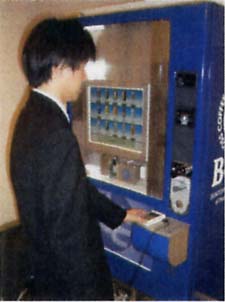 |
| Signs of the type on the right, which display ward, sub-ward locale, and block information, are attached to structures all over Tokyo. However, they can't be read by the visually disabled, and they are not very meaningful to non-Japanese speaking foreigners, unless they have access to maps with romanized place names. By incorporating an electronic tag into these signs that can be read by the Ubiquitous Communicator, the visually disabled will be able to discover where they are, and foreigners will be able to reference map data from on-line information providers. Such a system will also allow the Ubiquitous Communicator user to follow a preplanned route and make possible the provision of new types of information. |
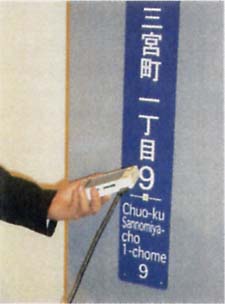 |
| Buying the correct train ticket, particularly when numerous line changes have to be made, is always difficult for the visually disabled and foreigners in large cities like Tokyo. The Ubiquitous Communicator will allow the visually disabled and foreigners to get the proper information about how to get to where they are going, how much to pay, etc. It could also be used as a train pass and/or electronic money. |
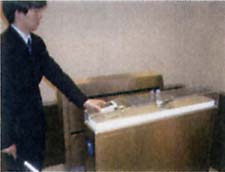 |
During the post press conference demonstration, Mr. Sadao Hasegawa, who attended the press conference, addressed the members of the press. He said that he himself had fallen from platforms four times, which led to him being hospitalized. Thus these TRON-based technologies represent a dream for the disabled, which is why he has been helping the TRON Project since 1987. Prof. Sakamura said that the Japanese government is helping with the development of these technologies, since government guidelines are needed for safety (e.g., the strength of radio waves, etc.), privacy, and so on. However, there will be no commercial advantage to Japanese companies as a result of Japanese government participation. Prof. Sakamura once again pointed out that the technologies are open and multi-platform. Moreover, since a large number of foreign companies, both hardware and software vendors, have already joined the T-Engine Forum, many of them will benefit from ubiquitous networking infrastructure currently under development in Japan.
The Ubiquitous ID Center announced on March 19 that it had certified as Class 1 ucode tags two electronic tags developed by Fujitsu Ltd. These are the MB89R116 and the MB89R118, both of which operate on the high frequency band of 13.56 MHz and are compatible with the international standard for non-contact IC tags known as ISO/IEC15693. The ISO/IEC15693 standard allows for identification as ranges of 10 to 70 centimeters, or approximately 4 to 28 inches. In addition to their non-contact nature, another feature of these chips is that they are equipped with 2 kilobytes of nonvolatile ferroelectric random access memory, or FRAM, which is a considerable amount of memory in the world of electronic ID tags. The latter of these two chips, the MB89R118, is a higher performance version of the former. A list of the tags approved for use by the Ubiquitous ID Center as of March 2004 is given below. Note that it also contains barcodes, which are not a part of the Auto-ID project that began in the U.S.
|
|
||||
| Date Certified | Cert. No. | Cert. Class | Tag Name/Type | Vendor Name |
| 2003/6 | 01-001 | Class 1 | µ-chip | Hitachi |
| 2003/6 | 01-002 | Class 1 | Tjunction | Toppan Printing |
| 2003/6 | 04-001 | Class 4 | eTRON/16-AE45X | UNL, Univ. of Tokyo, Renesas Technology |
| 2003/11 | 00-001 | Class 0 | barcode | Sato |
| 2003/11 | 00-002 | Class 0 | barcode | Toppan Printing |
| 2003/12 | 00-003 | Class 0 | barcode | Dai Nippon Printing |
| 2004/3 (New) | 01-003 | Class 1 | MB89R116 | Fujitsu |
| 2004/4 (New) | 01-004 | Class 1 | MB89R118 | Fujitsu |
Personal Media Corporation announced on March 11 that it had begun marketing via direct sales a new T-Engine-based embedded appliance called "Teacube," which made its debut as T-Cube--and was quickly dubbed the "tangerine computer"--at the annual TRON show back in December 2003. Teacube, which is actually an extremely compact personal computer CPU that fits within the palm of your hand, will be sold at a standard price of 198,000 yen (consumption tax not included), and it will bundled with the BTRON3-specification operating system and BTRON applications modified and/or recompiled for use on top of the T-Engine open development platform. Personal Media says it is aiming the Teacube at kiosk applications in organizations such museums, libraries, train stations, and retail outlets. The Teacube hardware and software specifications are given below. For further information about the product or to place an order, please contact Personal Media's Sales Department.
|
|
|
| CPU | NEC Electronics VR5701 (MIPS core, 266/333 MHz) |
| Flash memory | 16 megabytes |
| RAM | 64 megabytes |
| Input/output I/F | USB x 2, RS-232 (serial) x 2, Compact Flash (IDE), 100Base-TX, external CRT output (1,280 x 1,024 dot; 65,536 colors max.), eTRON, microphone input, headphone output |
| Other functions | Real-time clock (RTC) |
| Dimensions | 53 mm x 52 mm x 45 mm (external dimensions of the case) |
| Weight | 165 grams (including case) |
|
|
|
| OS, middleware, etc. | T-Monitor, PMC T-Kernel, T-Kernel Extension, PMC T-Shell |
| Basic applications | Basic browser, basic text editor, basic figure editor, MicroScript (visual programming language), system environment settings, user environment settings, network settings |
|
|
|
| Optional software pack | Basic spreadsheet, MicroCard (card database software), Character Search |
Personal Media Corporation announced on March 22 that it had begun marketing via direct sales a new Windows XP Professional-based notebook personal computer with the company's BTRON3-specification Cho Kanji operating system and bundled applications preinstalled in separate partition. The main selling points of the new "Cho Kanji Note Y2C" in comparison to past offerings of the same kind are that it is equipped with a 14.1-inch, SXGA (1,280 x 1,024-dot) TFT full-color liquid crystal display and a DVD-ROM&CD-R/RW drive in a 1.5 kilogram package. Cho Kanji Note Y2C, which is priced at 273,000 yen, uses a Pentium M microprocessor running at 1.2 GHz and the Intel 855GME chip set. It is equipped 256 megabytes of main memory, and it also sports a 40 gigabyte hard disk drive. For communications, there are 100BASE-TX/10BASE-T LAN and IEEE802.11b/g-based Wi-Fi interface functions. For further information about this product and ordering information, please contact Personal Media's Sales Department.